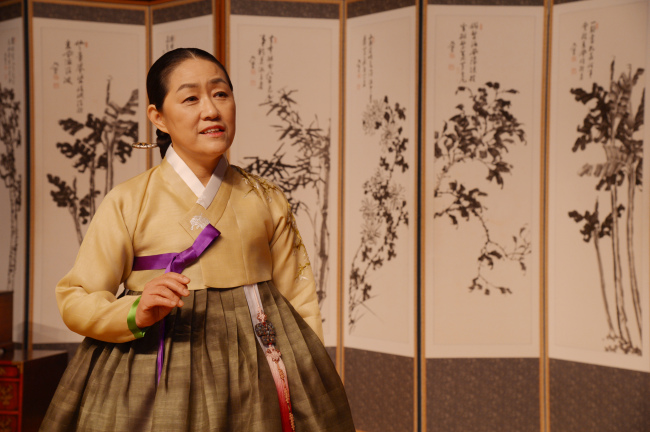[Herald Interview] Preserving tradition
Gugak chief on mission to popularize neglected traditional genre, while upholding artistry
By Korea HeraldPublished : Jan. 11, 2015 - 21:04
Clad in a beautiful, yellowish-green hanbok and her hair pulled back in a tight bun at the back of her neck, Kim Hae-sook looks like a living embodiment of Korean tradition.
In fact, she would be nothing, if not for the pride of the tradition to which she has devoted her entire life and now officially represents.
The 60-year-old is a master of the gayageum, a 12-stringed Korean zither; an authority in its academic studies and the president of the National Gugak Center, a state-run institute dedicated to the promotion of traditional Korean music, gugak.
Kim’s love affair with gugak dates back to her middle school days.
“At school, teachers would repeatedly tell us such phrases like ‘gugak is the container of the soul of Korean people’ or that our great masters ‘learned gugak with one hand always on their heart,’” she said at her office in southern Seoul on Wednesday.
“At a young age, I didn’t know exactly what they meant, but I could sense that what I was learning was very important.”
Trained in gugak in the most elite way, she went to the national gugak middle school, the national gugak high school and then Seoul National University’s gugak department.
Over the years, while she honed her gayageum skills and studied its history and musical theories, Korea went through a radical transformation, which she described as “industrialization, urbanization and Westernization.”
“People my age went crazy about American pop songs. They listened to the radio (which aired pop songs) and sang along, although they didn’t know the English lyrics,” she said.
In fact, she would be nothing, if not for the pride of the tradition to which she has devoted her entire life and now officially represents.
The 60-year-old is a master of the gayageum, a 12-stringed Korean zither; an authority in its academic studies and the president of the National Gugak Center, a state-run institute dedicated to the promotion of traditional Korean music, gugak.
Kim’s love affair with gugak dates back to her middle school days.
“At school, teachers would repeatedly tell us such phrases like ‘gugak is the container of the soul of Korean people’ or that our great masters ‘learned gugak with one hand always on their heart,’” she said at her office in southern Seoul on Wednesday.
“At a young age, I didn’t know exactly what they meant, but I could sense that what I was learning was very important.”
Trained in gugak in the most elite way, she went to the national gugak middle school, the national gugak high school and then Seoul National University’s gugak department.
Over the years, while she honed her gayageum skills and studied its history and musical theories, Korea went through a radical transformation, which she described as “industrialization, urbanization and Westernization.”
“People my age went crazy about American pop songs. They listened to the radio (which aired pop songs) and sang along, although they didn’t know the English lyrics,” she said.

Always a good student and never daring to stray from her chosen field, Kim never really caught on to this craze.
“I didn’t even read comic books, because comic books back then were deemed (by parents and teachers) a distraction for students.”
“From very early on, I had a clear goal that I wanted to excel both as a gayageum performer and a gugak theorist.”
Her tenacity and dedication of more than 40 years paid off in January last year, when she was picked to run the national gugak center.
Now as the chief campaigner of gugak, she faces the immense task of bringing the neglected genre closer to the Korean public.
It is a daunting task, she admits. Particularly so, as she refuses to compromise her high standards in terms of artistry and sincerity.
“Our musical ears are so accustomed to Western music. Music education at school is all about Western music,” she lamented.
Still, there are many positive signs, she said, as new attempts by gugak musicians to make it more relevant to modern-day Koreans continue to spring up.
In one such effort and what she recalled as the most memorable event in her first year in office, the gugak center staged an original theatrical performance “Gongmudoha (Don’t Cross That River).”
“I sat through all nine nights of the performance,” Kim said, saying the show had a special meaning to her.
“I wanted to show, not by words but through this performance, my answer to the question of how we should popularize gugak.”
Staged at the gugak center in November, the production packed almost every element of tradition, from court music to shamanism, into an original opera. It is credited for beautifully weaving together different types of gugak and transforming the traditional sounds into a perfect overture, duets and arias.
Kim plans to stage the opera once again at the end of this year, targeting those who like to celebrate a year’s end with a cultural experience.
“What about going for an original Korean performance, instead of the ballet ‘Nutcracker’ or Beethoven’s symphony ‘Choral?’” she touted.
By Lee Sun-young (milaya@heraldcorp.com)
-
Articles by Korea Herald




















